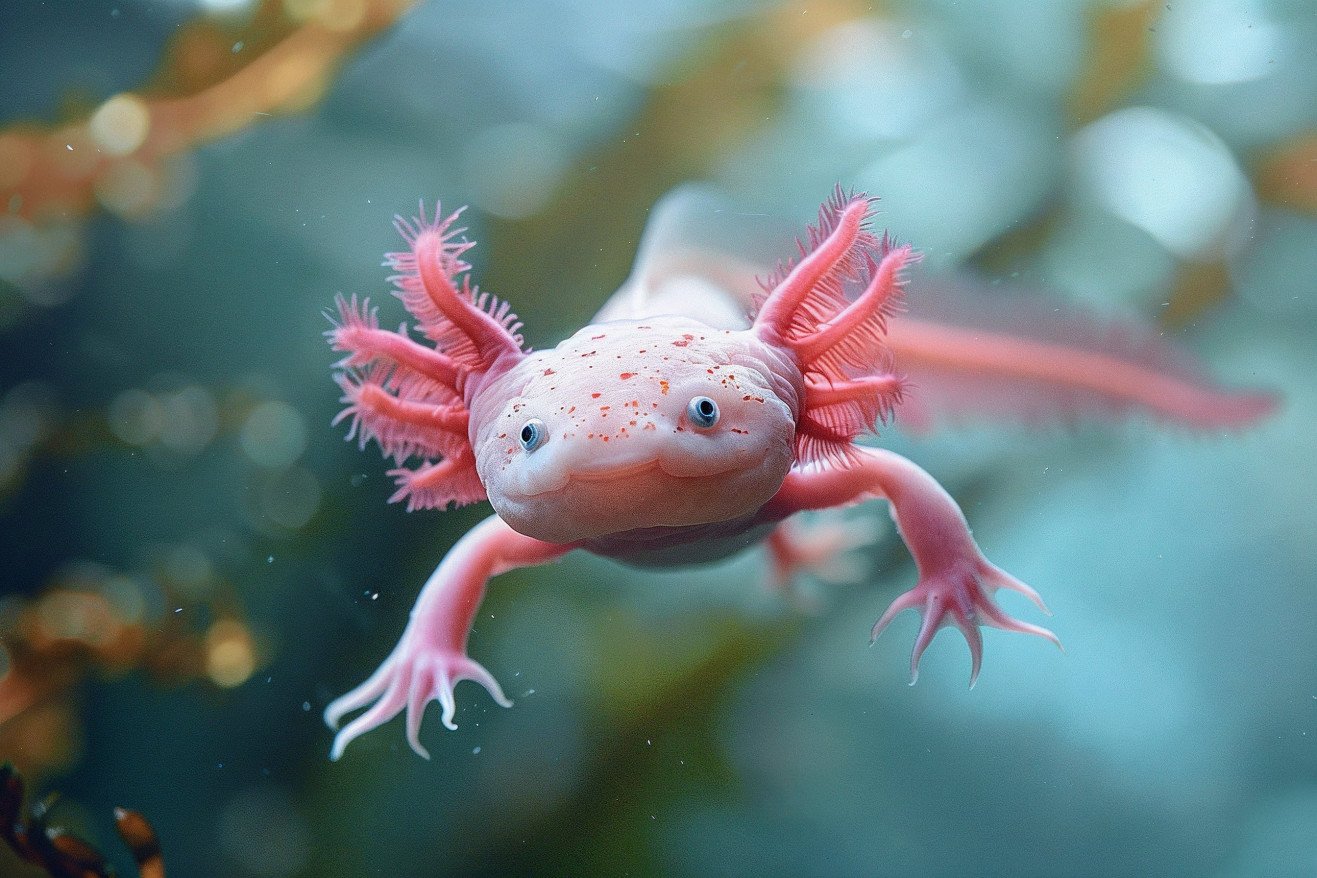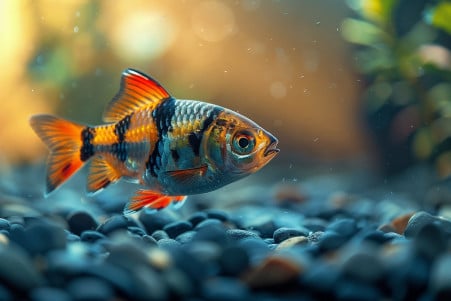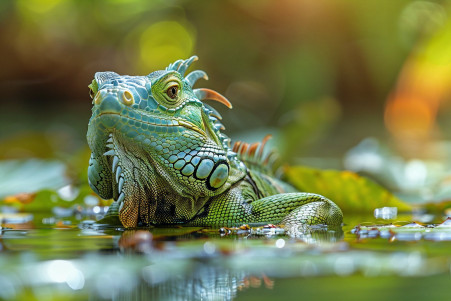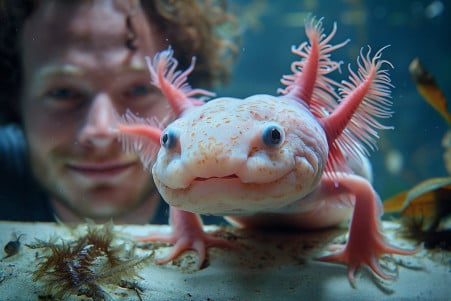Can Axolotls Live on Land? Understanding Their Aquatic Nature
11 March 2024 • Updated 10 March 2024

With their elegant swimming and otherworldly appearance, axolotls seem perfectly suited to life in the water. But does this mean they can never leave it? The short answer is that axolotls are completely aquatic and cannot live on land. They have evolved to be underwater animals, with external gills for breathing and skin that must remain moist. Prolonged exposure to land can hurt or even kill an axolotl.
This article will explain why axolotls are so tied to their aquatic environment by drawing on a range of studies in evolutionary biology, amphibian physiology, and environmental science. By taking a multidisciplinary perspective, we can gain insight into the special adaptations that make the axolotl’s life in the water mandatory, and in the process, we can learn about the dangers and consequences of exposure to land for this incredible species.
Can axolotls live on land?
Following the Genetics of the Water-Dwelling Axolotl
The axolotl, or Ambystoma mexicanum, is an amazing example of neoteny, an evolutionary phenomenon where an animal reaches sexual maturity but never fully develops into an adult. The axolotl never loses its larval gills or its finned tail, and a deep dive into the axolotl genome has shown that these traits are due to genetics that are inextricably linked to the animal’s permanent aquatic environment.
The axolotl’s large genome has also shown that the animal’s genetics are full of clues about the regulators of tissue development that have kept the axolotl from evolving into a land animal.
According to the International Environment Library Consortium, the axolotl’s evolutionary split from its closest relatives probably happened between 10 and 12 million years ago. During this time, the axolotl’s genome was shaped by a great deal of transposon activity, which led to the expansion of certain genetic sequences.
This has resulted in a genetic code that carefully controls the axolotl’s ability to regenerate complex tissues like limbs while also ensuring that the animal remains in the water.
These genetic changes have had a big impact: the axolotl doesn’t have the right physiology to move onto land. The axolotl’s gills, which are set up to extract oxygen from water, its skin, which is set up to stay moist, and the lack of evolutionary pressure to metamorphose have all combined to ensure that the axolotl’s fate is tied to the water.
Knowing this genetic background makes it possible to look at the specific physiological traits that have made sure the axolotl stays in the water.
Axolotls’ Gills and Permeable Skin: Adaptations to Life in Water
Axolotls have a respiratory system that is highly specialized for their aquatic lifestyle. Their gills, which extend out in a series of delicate, feathery branches from either side of the head, are the main organs of respiration.
An article in ScienceDirect explains that axolotls rely on their gills to extract oxygen from the water and deliver it to the bloodstream. This adaptation means that axolotls can’t breathe on land because their gills would collapse without the support of water, preventing them from extracting oxygen from the air.
The skin of the axolotl is another example of a highly specialized adaptation that is essential for their life underwater. According to a paper in Development by The Company of Biologists, the axolotl’s skin is highly permeable, which allows for the absorption of water and dissolved nutrients and the excretion of waste products.
However, this also means that if axolotls are taken out of water, their skin will lose water at a rapid rate, leading to dehydration and a lack of oxygen.
In addition, axolotls have limbs that are highly specialized for life in the water. Their paddle-shaped limbs enable them to move and swim with ease in the water, but they don’t provide much support for movement on land. These adaptations—gills, permeable skin, and aquatic limbs—demonstrate the axolotl’s specialization for life in the water and show how severely compromised they would be if they were forced to live on land.
The Dangers of Terrestrial Life for Axolotls
When taken out of their aquatic homes, axolotls suffer immediate and severe consequences. Their bodies are not built to survive on land, and they react to dry environments with a number of physiological stress reactions.
According to a study in Reptile Knowledge, axolotls can only survive for short periods of time on land. During these periods, they experience stress as their skin dries and their gills lose functionality, which makes it impossible to breathe and can lead to death by suffocation.
The potential consequences of prolonged time on land can be dire. An assessment in PMC of anesthetic effects in axolotls found that even when axolotls are taken out of their natural environment in a lab setting, it can lead to significant physiological changes.
While this study specifically looked at the effects of anesthesia, it shows how the balance of an axolotl’s life processes can be thrown off when they are out of water, which can lead to long-term health problems like dehydration and organ failure.
The Guardian drives home the importance of an aquatic environment by pointing out the decreasing axolotl populations in the wild due to environmental disruptions. This not only shows how fragile their environment is but also how important water is to their survival and well-being. It’s important to protect their aquatic environments, not just for the sake of the environment, but also to save this special species from the brink of extinction.
Amphibian Adaptations: Axolotls vs. Other Amphibians
Amphibians have adapted to a wide range of habitats, from strictly aquatic to primarily terrestrial. Research, including the studies referenced in ScienceDirect, has shown that while some amphibians have evolved to be able to resist desiccation and live in arid environments, axolotls are obligate aquatic animals that can’t survive outside of water.
As outlined in PubMed, the skin of most amphibians is much less resistant to evaporative water loss than that of reptiles, which means they need to live in a moist environment. However, axolotls don’t have the adaptations that have allowed some other amphibians to live in drier environments.
For example, the research cited in ScienceDirect has shown that the skin of some tree frogs is highly resistant to water loss, which has allowed them to live in less humid environments.
In contrast, axolotls have physiological limitations, including delicate gills and skin that needs to be kept moist, that make it impossible for them to live on land for any length of time. The genetic and physiological makeup of axolotls makes them more susceptible to desiccation than other amphibians, who have adapted to both aquatic and terrestrial life.
This comparison highlights the need to protect the aquatic environments that axolotls depend on, a need that’s reinforced by the IUCN’s assessment of axolotls as critically endangered. Protecting these environments is essential to the continued survival of axolotls in their natural aquatic habitats, which are best suited to their unique needs.
Bringing Attention to the Axolotl’s Endangered Status
By highlighting the axolotl’s endangered status, National Geographic draws attention to the wonder and peril of this extraordinary amphibian. As the axolotl’s natural populations teeter on the edge of extinction, the need to protect their watery homes has never been more urgent. The axolotl’s plight is a microcosm of the larger environmental crisis, in which habitat loss and invasive species have decimated their numbers.
In the heart of Mexico City’s Xochimilco borough, conservationists are using ancient chinampa farming methods to restore the axolotl’s natural habitat, according to The New York Times. The floating gardens represent a ray of hope, emphasizing the importance of habitat restoration in helping the species recover.
Smithsonian Magazine enumerates the many dangers the axolotl faces, including pollution and urban development, and emphasizes the urgent need for habitat conservation that is both immediate and ongoing.
Because the axolotl can only survive in clean, unpolluted water, these efforts are not only seen as a way to save the axolotl but also as a call to action to protect biodiversity and the rich life that exists below the water’s surface.
This collective work brings us closer to the understanding that the axolotl’s unique adaptations are not just a scientific endeavor but a cause that is essential to the species’ survival.
Meditating on the Aquatic Nature of Axolotls
Through our fascinating exploration into the world of axolotls, we have discovered why these unusual amphibians are inseparably connected to the water. Due to their extensive evolutionary history in aquatic environments, axolotls have preserved neotenic traits like gills and permeable skin that render them incapable of living on land.
Our deep dive into their genetics and physiology has shown that the challenges of living on land are too great, including their gills collapsing and their skin drying out.
The consequences of axolotls being exposed to land are dire and demonstrate how dependent they are on the unique adaptations that have evolved over millions of years. This knowledge is important for science and conservation alike. Restoration projects and studies have made it clear that we need to protect the axolotls’ aquatic homes, showing that it’s up to us to ensure the survival of these invaluable animals.
As we wrap up, let’s not just appreciate the axolotl’s underwater universe but also understand our responsibility to make sure the waters they live in remain undisturbed so that they can continue to live and thrive.


